|
 
 |
| ORIGINAL ARTICLE |
|
| Year : 2013 | Volume
: 8
| Issue : 3 | Page : 140-145 |
|
Phytochemical and antimicrobial screening of Capparis decidua stems
Amira M Nour1, Y. M. A. El-imam2
1 Department of Pharmacognosy, National University, Khartoum, Sudan
2 Department of Pharmacognosy, Faculty of Pharmacy, Ribat University, Khartoum, Sudan
| Date of Web Publication | 16-May-2014 |
Correspondence Address:
Amira M Nour
Department of Pharmacognosy, National University, Khartoum
Sudan
  | Check |
DOI: 10.4103/1858-5000.132602 
Background: The chromatographic separation of aerial parts of Capparis decidua, a woody medicinal plant, afforded one shikimate derivative, two acyclic terpenoids, four fatty acids, two sterols and two lupare triterpenoids Methods: in the present study, qualitative chemical screening of ethyle ether, methanol and water extracts of Capparis decidua stems (family Cappariaceae) showed the presence of triterpenes, fatty acids, carotenoids, coumarins and basic alkaloids. The methanol extract revealed the presence of condensed tannins, alkaloids, cardiac glycosides and anthocyanins while the aqueous extract revealed the presence of saponins, polyurenoids, condensed tannins, alkaloids and anthocyanine. All extracts were devoid of anthracene glycosides, flavanoids and reducing compounds. The antimicrobial activity of chloroform, methanol and water extract were studied in vitro against two standard gram positive bacteria (Bacillus subtilis and Staphylococcus aureus), two standard gram negative bacteria (Escherichia coli and Pseudomonas aeruginosa) and two standard fungal organisms (Aspergillus niger and Candida albicans) using the cup-plate agar diffusion method. Results: The results showed that the extracts had antimicrobial activity against at least two of the tested standard organisms; methanol extract was found to be highly active against the standard gram positive bacteria and Candida albicans, followed by the chloroform extract. The least antimicrobial activity was associated with the aqueous extract. Ten fractions were obtained when the chloroform extract was fractionated by the Preparative Thin Layer Chromatography (PTLC), their antimicrobial activity was studied in vitro against two standard gram positive bacteria (Bacillus subtilis and Staphylococcus aureus). Conclusion: The methanol extract fractionation gave five fractions and their antimicrobial activity was studied against Staphylococcus aureus and Candida albicans. Keywords: Antimicrobial, Capparis decidua, glucocapparin, phytochemical
How to cite this article:
Nour AM, El-imam Y. Phytochemical and antimicrobial screening of Capparis decidua stems. Sudan Med Monit 2013;8:140-5 |
| Introduction | |  |
Traditional people have been extensively using antimicrobial plants for thousands of years as part of their diet and pharmaceutical arsenal. Recently, people in industrialized nations have begun to express interest in these natural products. However, hospital-based medicine has been slow to embrace medicinal plants and extracts as a source of drugs. In October 1999 Cowan noted that while 25-50% of current pharmaceuticals are derived from plants, none are used as antimicrobials. Cowan noted that plants were rich in a wide variety of secondary metabolites, such as tannins, terpenoids, alkaloids and flavonoids, which have been found to have antimicrobial properties. Further, whereas it is estimated that there are 250,000-500,000 species of plants on Earth, a small percentage (1-10%) of these are used as foods by both humans and other animal species, leaving a huge potential for medicinal plants products development.
The chromatographic separation of aerial parts of Capparis decidua, a woody medicinal plant, produced one shikimate derivative, two acyclic terpenoids, four fatty acids, two sterols and two lupare triterpenoids. [1]
The flowers and fruits contain a series of hydrocarbons, aliphatic alcohol and B-carotene. The seeds contain glucocapparin (isothiocyanate glucoside), whereas the root barks contain isocodonocrine (spermidine alkaloid). [2] The aerial part of C. decidua contains alkaloids, flavonoids, sterols (triterpenes), tannins, cardiac glycoside and saponins. [3]
Ahmed et al., isolated two new spermidine alkaloids, 14-N-acetylisocodomcarpine and 15-N-acetylcapparisine from the root barkm of C. decidua.
Moreover, shoots and fruits of C. decidua were analyzed for their ascorbic acid contents during the summer and winter seasons. The amount of ascorbic acid was greater in summer than in winter in all parts of C. decidua.[4]
| Materials and Methods | |  |
Plant materials
C. decidua aerial parts were collected from Soba area in Southern Khartoum, on May 2005 and dried at room temperature.
The plant was authenticated by the botanists in Medicinal and Aromatic Plants Research Institute, Sudan.
Instruments and chemicals
A wide range of instruments and chemicals were used during the course of this study.
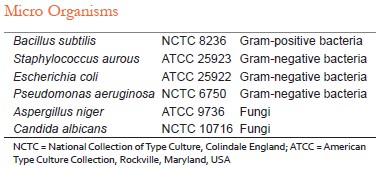
Phytochemical screening
The general chemical composition of C. decidua stems was determined by means of a qualitative chemical analysis by extraction with different solvents. The separation of the main classes of chemical constituents was obtained through successive extraction with ethyl ether. Following this, the vegetable product was extracted with methyl alcohol and finally with water.
An amount of 10-25 g of powdered vegetable product was extracted with ethyl ether in a continuous extraction apparatus (Soxhlet), until no more residues were left. The ether extracts were combined, filtered and concentrated up to 40-50 ml. The lipophilic constitute were identified. The rest of the dry vegetable product, after extraction with ethyl ether, was extracted with methanol. The filtered solutions were combined and concentrated up to 50 ml and then the chemically active extracted constituents were identified by means of some specific reactions for the alcoholic or hydrolyzed extract.
The vegetable product was extracted with ether followed by alcohol dried and extracted in a conical flask with warm water for 20 min. The filtered solutions were concentrated up to a volume of 50 ml. In this case, once again, part of the reactions took place directly within the extracts, but to identify other active principles a previous hydrolysis was necessary.
Successive extractions for antimicrobial studies
A total of 150 g of the powdered plant were extracted by chloroform, methanol and water successively, using a continuous extraction method with the first two solvents and infusion for the aqueous one. The chloroform and methanol extracts were collected in pre-weighted containers, then evaporated under reduced pressure at room temperature to complete dryness using a rotator evaporator, whereas the aqueous filtrate was frozen at −4°C and concentrated; the concentrated extract was freeze dried. [5] The yields percentages were calculated and the residue obtained was kept in a refrigerator for antimicrobial studies.
| Isolation | |  |
The isolation was achieved by fractionating the crude extracts utilizing the preparative thin layer chromatography (PTLC) technique. Fractionation was carried on the methanol and chloroform extracts to study their fractions antimicrobial effects, since their crude extracts were tested for the same purpose and found to exert significant results, unlike the aqueous one which lacked that effect.
The stationary phase was silica gel. The mobile phases were toluene:ethyl acetate:methanol (9:1:0.5) and Toluene: Ethyl acetate:chloroform (9:1:1) for the methanol and chloroform extracts respectively. Detection was carried out by spraying small areas of the plates, about 1 cm from each sides of the PTLC chromatogram, with vanillin in concentrated sulfuric acid, [6] and detected under the ultraviolet lamp. The corresponding Rf values were calculated, the separated fractions were recovered by scraping off the adsorbent at the appropriate places on the developed plates the powder was eluted with acetone, and centrifuged to remove the adsorbent. [7]
Antimicrobial experiments
The cup-plate agar diffusion method was used with some minor modifications to assess the antibacterial activity of the prepared extracts. [8] A volume of 2 ml of the standardized bacterial stock suspension (10 8 -10 9 ) colony forming units per ml were thoroughly mixed with 200 ml of sterile molten nutrient agar, which was then kept at 45C.
A total volume of 20 ml aliquots of the inoculated agar were distributed into sterile Petri-dishes. The agar was left to set and four (10 mm diameter) were cut in each plate using a sterile cork borer (no. 4) and the agar discs were removed. Alternate cups were filled with 0.1 ml sample of each of the extracts using the adjustable pipette and allowed to diffuse at room temp for 2 h. Chloroform residue was dissolved in a mixture of methanol petroleum (2:1) and the plates were then incubated in the upright position at 37°C for 18 h; two replicates were carried out for each extract against each of the tested organisms.
After incubation, the diameter of the resultant growth inhibition zones were measured and the mean values were tabulated. The same method was adopted for the antifungal activity using Sabouraud dextrose agar as culture media.
| Results | |  |
Phytochemical screening
The phytochemical screening of the plant ether extract revealed the presence of volatile oils, fatty acids, sterols, triterpenes, carotenoids, basic alkaloids and coumarins [Table 1]. Analysis of the plant alcohol extract, showed the presence of tannins and alkaloidal salts. The extract was devoid of the reducing compounds. In the hydrolyzed alcohol extract the aglycone parts of coumarins glycosides, saponins glycosides as well as cardiotonic glycosides were found in the ether extract. It was devoid of anthracenoside and flavone aglycones. Anthocyanosides were detected in the acidic aqueous layer [Table 2]. The most hydrosoluble constituents were detected in the aqueous extract. Polyuronides, saponins, tannins, as well as alkaloidal salts were present. The extract was devoid of the reducing compounds and glucides. The same constituents of the hydrolyzed alcohol extract, were detected in the hydrolyzed aqueous extract [Table 3]. | Table 1: Phytochemical screening of Capparis decidua stems ether extract
Click here to view |
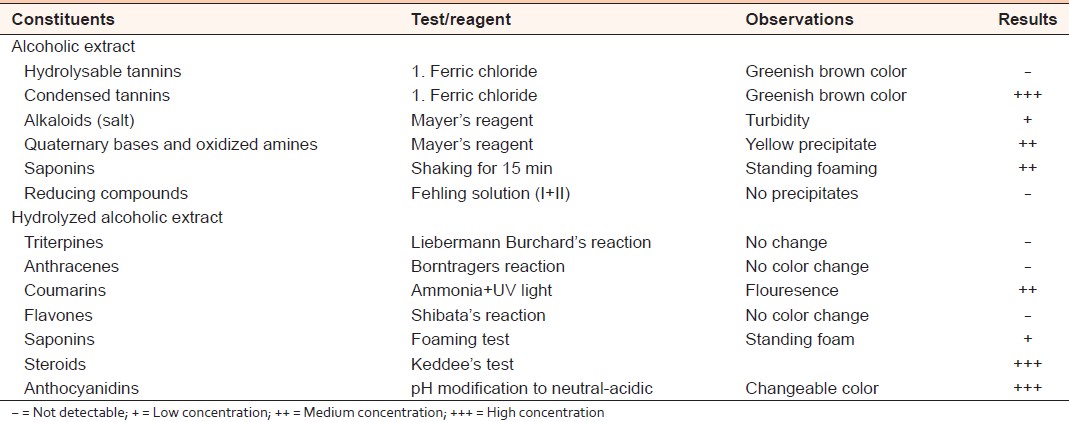 | Table 2: Phytochemical screening of Capparis decidua stems alcohol extract
Click here to view |
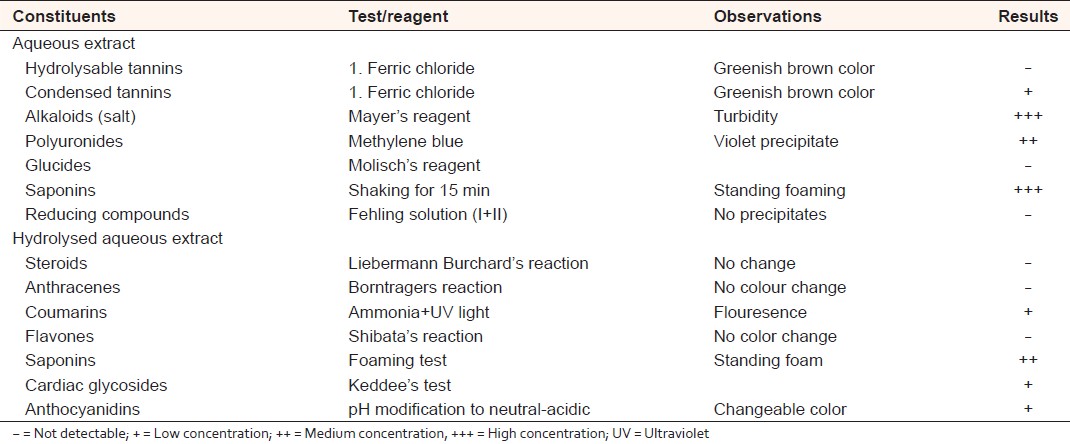 | Table 3: Phytochemical screening of Capparis decidua stems aqueous extract
Click here to view |
Antimicrobial activity results
The antimicrobial activity of stems crude extracts (chloroform, methanol and water), was studied. The methanol extract had a significant inhibitory effect on Staphylococcus aureus (S.a) and Candida albicans (C.a), and a moderate effect on Bacillus subtilis (B.s) Escherichia More Details coli and pseudomonas aeruginosa. It has no effect on Aspergillus niger.
The chloroform extract has a significant effect only on S.a, with slight effect on B.s. The aqueous extract has no antimicrobial activity. The mean diameters of the resultant growth inhibition zones were tabulated in [Table 4].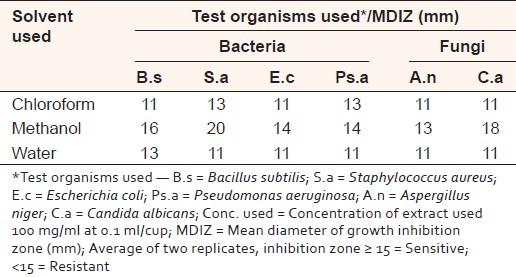 | Table 4: Screening for antimicrobial activity of Capparis decidua stems extracts against standard organisms
Click here to view |
The mean diameters of the growth inhibition zones were compare for three crude extracts against the test organisms [Figure 1].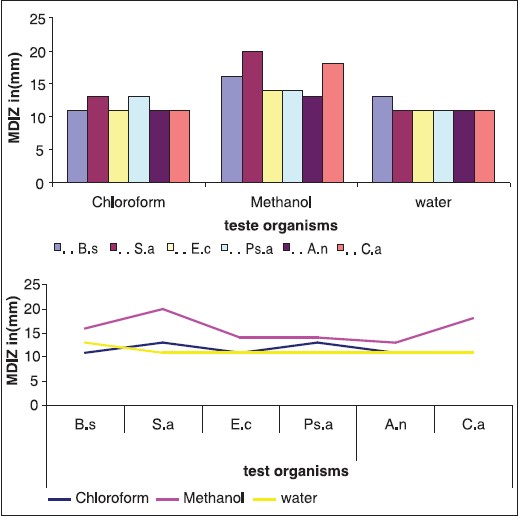 | Figure 1: Comparison of the resultant mean diameters of growth inhibition zones of extracts of Capparis decidua stem (B.s: Bacillus subtilis, S.a: Staphylococcus aureus, E.c: Escherichia coli, Ps.a: Pseudomonas aeruginosa, A.n: Aspergillus niger, C.a: Candida albicans)
Click here to view |
The antimicrobial activity of the chloroform extract fraction had been tested only on the two Gram-positive organisms, since its crude extract was found to be devoid of inhibitory effect against both the Gram-negative bacteria and fungi. Whereas the methanol extract fractions had been tested only on the S.a and C.a. [Table 5] and [Table 6], [Figure 2] and [Figure 3] shows those results respectively.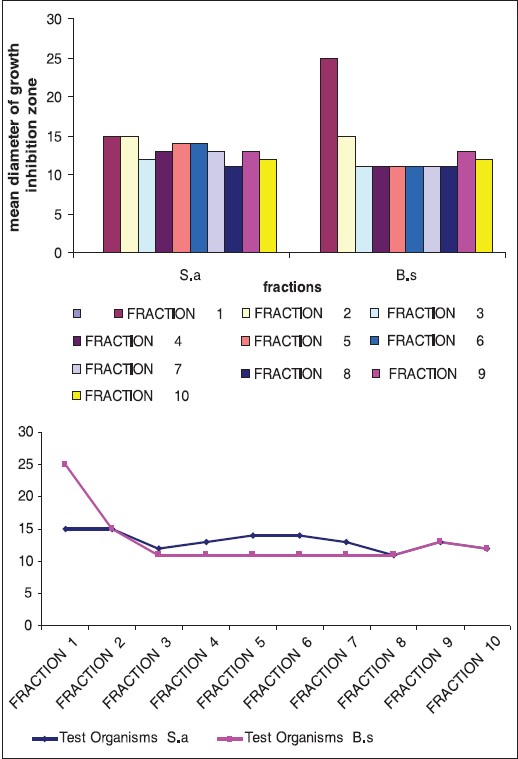 | Figure 2: Comparison of the resultant mean diameters of growth inhibition zones of chloroform extract fractions of Capparis decidua stems
Click here to view |
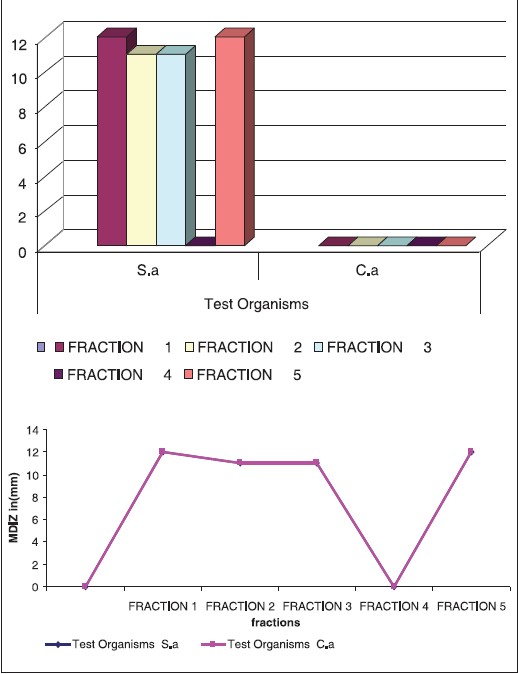 | Figure 3: Comparison of the resultant mean diameters of growth inhibition zones of methanol extract fractions of Capparis decidua stems
Click here to view |
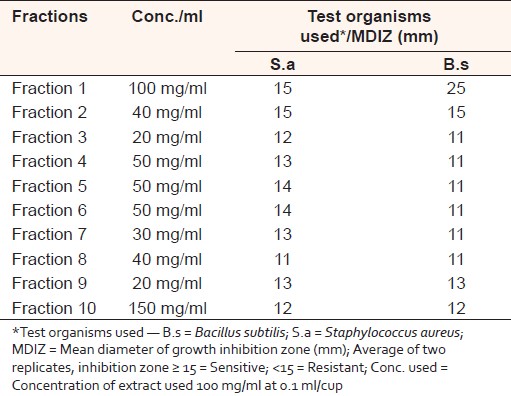 | Table 5: Screening for antimicrobial activity of Capparis decidua chloroform extracts fractions against standard organisms
Click here to view |
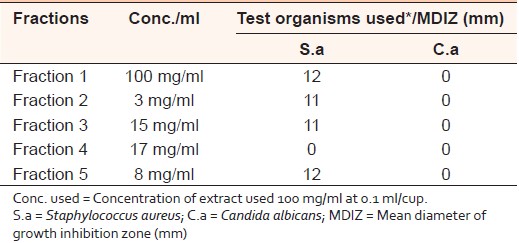 | Table 6: The diameters of the resultant growth inhibition zones of Capparis decidua stems alcohol extract fractions
Click here to view |
| Discussion | |  |
Qualitative phytochemical screening results were similar to those reported by Abdel-Mogib et al. [1] (The chromatographic separation of C. decidua, aerial parts extract, produced one shikimate derivative, two acyclic terpenoids, four fatty acids, two sterols and two lupare triterpenoids). The methanol and water extracts revealed similarities in their constituents but there were variations in the detected amounts in each extract according to the metabolites solubility, and hence all these constituents could be extracted directly with 70% methanol instead of the successive extraction with methanol and water. Alkaloids seemed to be the major constituent of C. decidua stems, been detected as free bases in the ether extract, as salts, quaternary bases and oxidized amines, in the methanol extract and as alkaloidal salts in the aqueous extract. A previous study of C. deciduas alkaloids, have led to the isolation of four novel spermidine alkaloids named capparidisine, capparisine, capprisinine and N-acetyl capparisine. [9] Ahmed et al., [10] two new spermidine alkaloids, 14-N-acetylisocodomcarpine and 15-N-acetylcapparisine have been isolated from the root bark of C. decidua. Methanol extract exhibit a significant antimicrobial activity against the two standard Gram-positive bacteria and C.a. This antimicrobial activity can be correlated with the phytochemical screening results, that high concentrations of condensed tannins were detected in the methanol extract. Tannin toxicity for fungi, bacteria and yeasts is reviewed and compared with toxicity of related lower molecular weight phenols. [11]
| References | |  |
| 1. | Abdel-Mogib M, Ezmirly ST, Basaif SA. Phytochemistry of Dipterygium glaucum and Capparis decidua. J Saudi Chem Soc 2000;4:103-8. 
|
| 2. | ELGhazali GE, Eltohami MS, Elegami AA. Medicinal plants of the Sudan, part III medicinal plants of White Nile Province. Khartoum: National Centre for Research, Khartoum University Press; 1994. 
|
| 3. | AL-Yahya MA. Phytochemical studies of the plants used in traditional medicine of Saudi Arabia. Fitoterapia 1986;LVII:179-82. 
|
| 4. | Goswami A, Yadav L. Seasonal evalution of ascorbic acid contents of two arid zone plants Capparis decidua and Zizyphus mauritiana. J Phytochem Res 1994;7:87-8. 
|
| 5. | Komolafe OO, Anyabuike CP, Obaseki AO. The possible role of mixed function oxidases in the hepatobiliary toxicity of Azadirachta indica. Fitoterapia 1988;LIX:109-13. 
|
| 6. | Tyihak E, Vagujfalvi D, Hagony PL. Gas and thin-layer chromatographic separation of the stereo-isomers of farnesol and its derivatives. I. Trans-trans and cistrans farnesol and derivatives. J Chromatogr 1963;11:45-9. 
|
| 7. | Harborne JB. Phytochemical Methods. 2 nd ed. New York: Chapman and Hall; 1983. 
|
| 8. | Kavanagh F. In: Kavanagh F, editor. Analytical Microbiology. Vol. 11. New York, London: Academic Press, 1972. p. 11. 
|
| 9. | Shoib A. Studies on alkaloids of Capparis deciduas. PhD Thesis. Karachi: University of Karachi; 1986. 
|
| 10. | Ahmed VU, Ismail N, Arif S, Amber AR. Two new N- acetylated spermidine alkaloids from Capparis decidua. J Nat Prod 1992;55:1509-12. 
|
| 11. | Scalbert A. Antimicrobial properties of tannins. Phytochemistry 1991;30:3875-83. 
|
[Figure 1], [Figure 2], [Figure 3]
[Table 1], [Table 2], [Table 3], [Table 4], [Table 5], [Table 6]
|